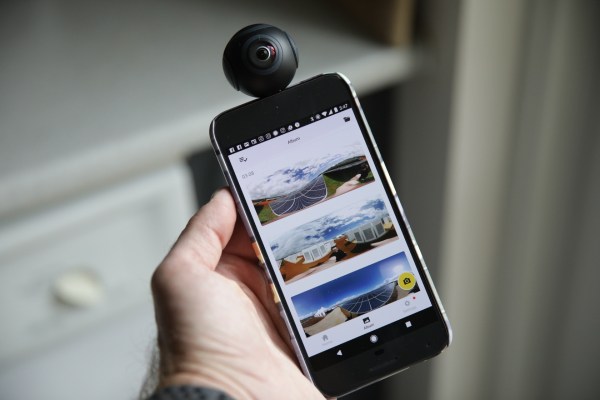You can share 360-degree video and images in more places than ever before, but how to capture that content in the first place? Insta360 has built a bit of a name for itself creating relatively inexpensive add-ons for the smartphone you already have that’d the ability to use those devices to record and broadcast in 360. The $129.99 Insta360 Air is the company’s Android device accessory, and it’s a very hand addition to your photographic toolkit in a small package.
The Insta360 Air is a small sphere with either a USB-C or micro USB connector, depending on which version you buy, which will depend on what kind of Android smartphone you’re using it with. I was pairing it with a Google Pixel XL, which means I was using the USB-C version. The connector is hardwired into the ball itself, so make this choice wisely: you’ll have to buy another Insta360 Air if you ever switch connectors with a new device in the future.
Sticking with a dedicated connector means that the Air can be very simple in its design, usability and construction, however. It’s a hard plastic ball, which feels very solid and relatively rugged, and it comes with a soft silicone sheath that protects the lens elements on the two camera the Air uses to stick together its 360-degree photo. It’s a clever design for a case that takes up almost no additional space in your bad, and that also protects the cameras from bumps or shocks in case of a drop. Plus, it encloses the USB extension that sticks out of the spherical camera body, ensuring this won’t bend or get snapped off.
[gallery ids="1468792,1468793"]
The ball itself works once you insert the USB connector into your phone. It’ll prompt you to install the app from the Google Play store if you haven’t, but otherwise it’ll launch the software. This will invert the orientation of the display on your phone, so that the camera is pointing the right way up when you’re looking at the image preview on the screen.
Taking photos or shooting video with the Insta360 Air is as easy as shooting either with your smartphone’s built-in camera. It takes some getting used to at first, since obviously you’re not focusing on the same things that you’d be aiming for when trying to get the “right” shot. Interesting elevation, either holding the phone up high or down low, seems to produce good results. You can also set the key or starting frame after the fact, so you don’t need to think that much about what you’re currently pointing the camera “towards.”
Pictures are easy to share via various social networks, including Instagram, but they especially shine on Facebook. The native 360-degree support on the social network means your photos will instantly work in the FB feeds of your friends, letting them navigate around the image by moving their phone around when viewing on mobile.
Image quality is good, too, as you can see from the embedded images above. You start to see the limits of the resolution, which Insta 360 says is “3K,” when you do things like view them in immersive VR via Google Photos in Daydream, for instance – but for viewing on desktop and mobile via embeds lie those found in this article, there’s plenty of detail and the quality looks excellent, especially given how much software is at work behind-the-scenes stitching the 180-degree images from the two cameras together and making sure the image doesn’t look wonky.
In short, the Insta360 Air, like the iOS-focused Insta360 Nano before it, is a great option for affordable, portable capture of surround imagery and video. Unlike the Nano, it lacks a standalone battery and so can’t work without a smartphone, but it has a new power: using a flexible USB cable included within, it can be used with a computer for tethered live-streaming, eliminating battery concerns and platform issues you might run into with a smartphone.
Basically, it’s a tool that adds a lot of flexibility to your photographic arsenal, and it definitely earned a permanent spot in my camera bag.
